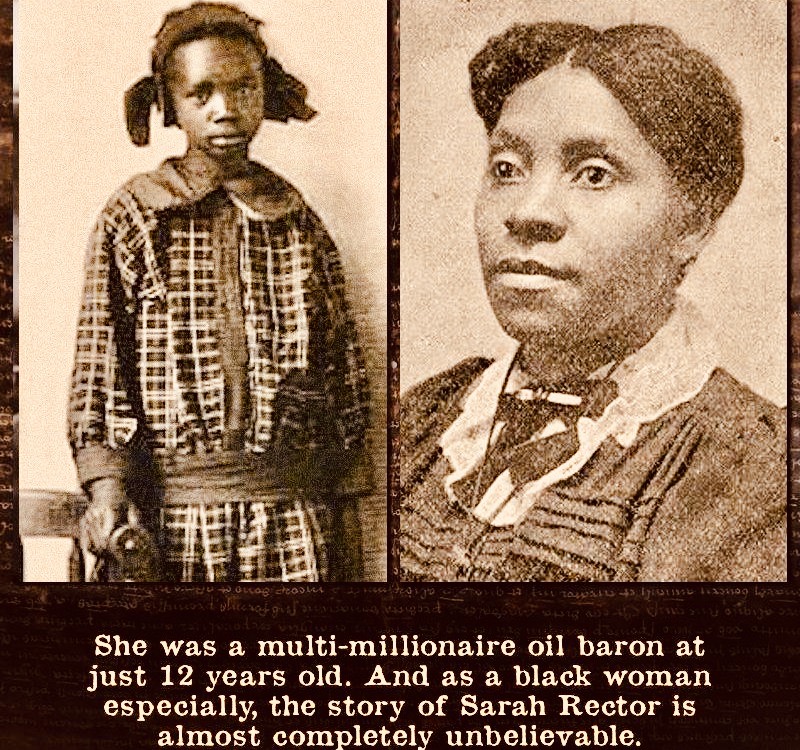‘The Richest Colored Girl in the World’ by The Union Review

“SARAH RECTOR: ‘THE RICHEST COLORED GIRL IN THE WORLD'”
Sarah Rector Was a Poor 10-Year-Old Who Became a Millionaire Oil Baron
Sarah Rector received international attention in 1913 at the age of eleven when the Kansas City Star printed the headline, “Millions to a Negro Girl.” Rector’s life soon became a cauldron of misinformation, legal and financial maneuvering, and public speculation.
Rector was born to Joseph and Rose Rector on March 3, 1902, in a two-room cabin near Twine, Okla. on Muscogee Creek Indian allotment land. Both her parents had enslaved Creek ancestry, and both of their fathers fought with the Union Army during the Civil War.
When Oklahoma statehood became imminent in 1907, the Dawes Allotment Act divided Creek lands among the Creeks and their former slaves with a termination date of 1906. Sarah, her parents, her brother, Joe, Jr., and sister Rebecca all received land. Lands granted to former slaves were usually of poorer agricultural quality. The Rector’s allotment of 160 acres was valued at $556.50. That equates to $7,000 – $8,000 in today’s dollars.
When he didn’t have enough income to pay the $30 annual tax bill, Rector’s father leased Sarah’s allotment to the Devonian Oil Company of Pittsburgh, Penn. The family’s fortunes changed when wildcat oil driller B.B. Jones produced a “gusher” from that land, which brought in 2,500 barrels a day. Rector began receiving an income of $300.00 per day. Rector’s guardianship was then switched from her parents to a white man named T.J. Porter, a personal acquaintance of the Rectors. At the time, a law required Native Americans, black adults, and children who were citizens of Indian Territory with significant financial holdings to be assigned “well-respected” white guardians.
Multiple new wells were also productive, and Rector’s allotment became part of the famed Cushing- Drumright Field in Oklahoma. In the month of October 1913, Rector received $11,567.
Once her identity became public, Rector received numerous requests for loans, money gifts, and marriage proposals from four Germans, even though she was only 12.
In 1914, the Chicago Defender published an article claiming that her estate was being mismanaged by grafters and her “ignorant” parents and that she was uneducated, dressed in rags, and lived in an unsanitary shanty.
None of the allegations were true. Rector and her siblings went to school in Taft, an all-black town closer than Twine, they lived in a modern five-room cottage, and they owned an automobile. That same year, Rector enrolled in the Children’s House, a boarding school for teenagers at Tuskegee Institute in Alabama.
When Rector turned 18 in 1920, she left Tuskegee and moved her family to Kansas City, Mo. By this point, Rector was a millionaire who owned stocks and bonds, a boarding house, a bakery, the Busy Bee Café in Muskogee, Okla., and 2,000 acres of prime river bottomland.
The family moved into what would be known as the Rector Mansion. Legal wrangling over Rector’s estate and some mismanagement continued until she was twenty. That year Rector married Kenneth Campbell, and the couple had three sons, Kenneth, Jr., Leonard, and Clarence. Much was publicized about her “extravagant” spending on luxuries. Her marriage to Campbell ended in 1930, and in 1934 she married William Crawford.
When Rector died at age 65 in 1967, her wealth was diminished, partly from the Great Depression, but she still had some working oil wells and real estate holdings. Rector was buried in Taft Cemetery, Oklahoma. To learn more go to the link below:

